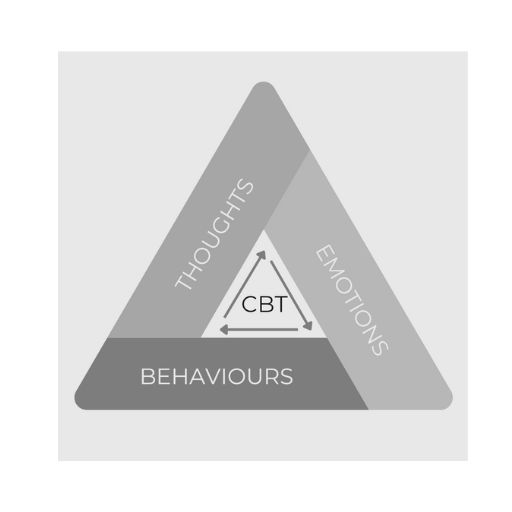The relationship between our thoughts, our feelings, and our behaviors runs deep. In every waking moment, our thoughts have power. They influence how you feel, and your feelings craft how you act. A healthy mindset helps you thrive. But if you may struggle with mental health, persistent negative thoughts can create distressing emotions that lead to damaging, even self-destructive, behaviors, like an angular loop that can’t be unbroken. In cognitive behavioral therapy (CBT), this is called the CBT triangle, or cognitive triangle — a visual diagram of how these three elements are inextricably interconnected, always interacting with each other to shape your experiences.
The CBT thought triangle is an indispensable tool because it shows how negative thoughts (cognition) can trigger emotions (feelings) like sadness or anxiety disorder, which in turn lead to behaviors (actions) that reinforce those thoughts. By learning to recognize and challenge these patterns through therapy, you can break the cycle and create healthier ways of thinking, feeling, and acting.
What Is Cognitive Behavioral Therapy (CBT)?
CBT is a structured, evidence-based form of psychotherapy that focuses on the connections between what you think, what you feel and how you act. It’s widely used to treat issues like anxiety, depression or substance use disorders, since CBT is grounded in the philosophy that by identifying, understanding and changing unhelpful thought patterns, you can begin to cultivate a better emotional framework that will lead to more constructive behaviors.
For example, if someone suffering from depression also has a drug addiction (which can qualify for a dual diagnosis), their negative perspective may be causing them to self-medicate. This connection between their thinking, feelings, and actions may lead them to keep drinking or using substances, which can exacerbate their mindset and mood.
“CBT helps you become aware of inaccurate or negative thinking so you can view challenging situations more clearly and respond to them in a more effective way,” notes the Mayo Clinic.
Psychiatrist Aaron Beck developed CBT in the 1960s after observing some of his patients with depression and noticed what are called “cognitive distortions” in their mindsets — thought patterns not rooted in reality that can cause someone to adopt a negative or fatalistic worldview.
“(Beck’s) empirical observations led him to start viewing depression not so much as a mood disorder but as a cognitive disorder,” notes the National Institutes of Health. “Based on his clinical observations and empirical findings, Beck outlined a new cognitive theory of depression.”
Main Principles of CBT
Here are the main principles of CBT:
Connection Between Thoughts, Emotions, and Behavior
At the heart of CBT is the knowledge that your thoughts, emotions and behaviors are linked together — each one is influenced by the others all the time. A single negative thought or belief can lead to other similar beliefs, and these can lead to a cascade of emotions that validate these thoughts and lead to actions that reinforce the negativity.
For instance, someone with low self-esteem may develop limiting thoughts and opinions about themselves. “I’m not good enough,” they might think. Feeling sad, hopeless, worthless, or that nothing or nobody will help, they may withdraw or avoid situations or challenges, like not making an effort to meet new people or seeking a promotion at work. CBT is aimed at helping you recognize how to break this cycle.
“Certain thinking patterns are often associated with anxiety or depression,” notes an article from Harvard Medical School. “Therapists help people recognize these patterns and then work with patients to find broader, more flexible ways to cope with difficult situations.”
Changing Unhelpful Patterns of Thought
To look at your thought patterns objectively and recognize how they may be enabling negative behaviors or hindering you from pursuing positive habits is one benefit of CBT. The Harvard study continues, “Paying attention in the present moment without judgment, or mindfulness — is a common CBT tool.”
And while you cannot always control your circumstances, you can control how you think about them. When we become so accustomed to distorted, negative thinking, it becomes habitual and normalized.
Verbalizing to a therapist these patterns of negative, distorted thinking creates a chance to unpack why you feel this way and how they aren’t serving you well. In turn, it becomes a valuable opportunity to unlearn these habits and replace them with more constructive perspectives, ultimately improving how you feel and subsequently act.
“By trying new things instead of avoiding them, you begin to change your thought patterns,” says the Harvard study. “These more adaptive thinking patterns then make it more likely you will try new or challenging experiences in the future, thereby increasing your self-confidence.”
Problem-Focused and Goal-Oriented
“In many studies, CBT has been demonstrated to be as effective as, or more effective than, other forms of psychological therapy or psychiatric medications,” notes the American Psychological Association.
Because of its practical, solution-focused structure, CBT is not about dwelling on the past. Rather, it encourages you to focus on present and current problems and set achievable goals.
According to Harvard Medical School, your homework after leaving a session may include self-monitoring — paying close attention to experiences, events, or times of the day that might trigger negative thoughts or feelings. From there, you’ll work on developing positive, reaffirming self-talk in future sessions and work with your therapist to confront any mental and emotional barriers with actionable strategies.
What Is the CBT Triangle?
The CBT triangle graphic represents how easily our thoughts, emotions, and behaviors are intertwined. It illustrates how one’s thoughts can lead to the development of emotions, which then lead us to act on those emotions, and how these three aspects continually interact with one another, forming the foundation of many CBTs for mental health and substance use disorders.
Notice how the CBT triangle is bi-directional: just as self-defeating thoughts can lead to pessimistic emotions and harmful behaviors, positive behaviors can lead the triangle in the opposite direction, fostering uplifting emotions and empowering thoughts.
Here’s a breakdown of the CBT triangle explained:
Thoughts
“Ruminative thinking — negative thought patterns that loop repeatedly in our minds — is common in many psychiatric disorders,” notes Harvard Medical School. “This type of thinking also contributes to the unhappiness and alienation that many people feel.”
This quote encapsulates how your thoughts are the starting point of the CBT triangle. Our mental thoughts manifest from our neural processes, the internal dialogue that shapes how we interpret the world around us. A belief as simple as “I’m a failure” can trigger feelings of sadness or frustration and lead to behaviors like procrastinating or avoiding attempts to change.
Through CBT, you can learn to recognize these automatic thoughts and intercept them, the first step in breaking the cycle.
Emotions
Whether you’re feeling happy, sad, or angry, what you think can impact what you feel, notes a University of Minnesota study. “Thoughts and emotions have a profound effect on one another,” notes the article. “Thoughts can trigger emotions (worrying about an upcoming job interview may cause fear) and also serve as an appraisal of that emotion (‘this isn’t a realistic fear’). In addition, how we attend to and appraise our lives has an effect on how we feel.”
This second point on the CBT thought triangle, emotions are your body’s response to your thoughts. Emotions aren’t objectively good or bad — they are signals generated by our thoughts, but too often we believe that they can’t be altered.
However, the university states that our emotions are, like our thoughts, very malleable and can be changed. “Certain types of mental training, such as mindfulness or positive thinking, can affect our perceptions of the world and make us feel calmer, more resilient and happier.”
Behaviors
“We act, react, and behave (overtly or covertly) in response to our thoughts and emotions,” notes one study on CBT. “When our thinking and feelings are negative, our behaviors may be maladaptive — sometimes avoidant or self-destructive.”
How we respond to a situation is linked to our thoughts and emotions. For instance, if you feel nervous about speaking up in a group discussion, you might stay silent, which then reinforces thoughts and feelings of low value on the CBT triangle. CBT helps you replace these behaviors with healthier choices, creating a positive feedback loop.

How Does the CBT Triangle Establish Negative Patterns?
Negative patterns often develop when one point of the CBT triangle — be it thoughts, emotions or behaviors — creates a ripple effect that reinforces the others. For example:
- Thought: “I always fail at everything I try.”
Emotion: Hopelessness or frustration.
Behavior: Giving up before even starting.
- Thought: “I’m unlovable and nobody cares about me.”
Emotion: Loneliness or sadness.
Behavior: Withdrawing from relationships.
Positive patterns, on the other hand, can be created by interrupting this cycle. For instance:
- Thought: “I can improve if I keep practicing.”
Emotion: Motivation or hope.
Behavior: Taking small, realistic steps toward a goal.
Although these patterns can feel automatic, they’re not permanent. Your internal dialogue and how it affects your outward behaviors are a type of relationship that CBT interventions and CBT techniques can help change.
How to Break the CBT Triangle Cycle
You can intentionally reshape your own CBT triangle to create healthier patterns — in mind, in sentiment, in effort. By focusing on actionable changes within any part of the triangle, you can positively influence the other points and break free from negative cycles. Here’s how to use it as a tool for growth:
Identify Negative Thoughts
The first step is to become aware of your automatic thoughts, since they often occur so quickly that they go unnoticed. Pay attention to your self-talk in challenging situations. Look at them objectively. Do they serve you well? Are they overly critical, pessimistic or cognitively distorted? For example, do you tend to think, “I always mess up,” or “This will never work out for me”?
Writing these thoughts down can help you see patterns more clearly, identify recurring triggers and understand how your thoughts affect your feelings and behaviors. This process provides you with a foundation for change by helping you catch triggers and unhelpful thoughts as they arise.
Challenge and Replace Negative Thoughts
Once you’ve identified unhelpful thoughts, the next step is to question their accuracy. Many of these thoughts are based on assumptions or worst-case scenarios rather than facts. Ask yourself:
- Is this thought realistic, or am I catastrophizing?
- What evidence supports or contradicts this thought?
- How would I respond if a friend had this thought about themselves?
By challenging cognitively distorted thinking, you can begin to replace it with more balanced perspectives. For instance, instead of “I’ll fail no matter what,” you might reframe it as, “This is difficult, but I can try my best and learn from the experience.” Reframing your thoughts allows you to shift your perspective. And over time, this shift in thinking can reduce emotional distress and help you approach situations with greater confidence and clarity.
Engage in Positive Actions
Acting is the most proactive effort to produce change, especially when thoughts and emotions have become so habitual. Instead of avoiding something because it feels overwhelming, try breaking it into smaller, manageable steps. Instead of outright avoiding a social situation because you think, “I’ll just say something stupid,” try attending and focusing on simply being present, in the moment, rather than perfect. Over time, these small victories can build confidence and create momentum.
Positive actions don’t have to be monumental to create meaningful change. Even small behaviors, like taking a walk when you feel stuck or reaching out to a friend when you feel lonely, can shift your mood and reinforce healthier thought patterns. These actions build momentum and help you create a cycle of positive reinforcement within the CBT thought triangle.
Acknowledge and Process Your Feelings
Emotions are a natural part of life, and trying to suppress or ignore them often backfires. Instead, take time to acknowledge and process what you’re feeling. Ask yourself: What is this emotion telling me? Why might I be feeling this way? Let your intuition guide you in these moments.
With a therapist, you might engage in mindfulness practices to open up your mental visibility and observe your emotions, feeling and behavior without judgment, while journaling can provide clarity by putting your feelings into words. Processing emotions in a healthy way makes it easier to respond thoughtfully — rather than impulsively.
Which CBT Therapists in Arizona Can Help?
Understanding how the CBT triangle works can help you change it and how you live your life. Having an awareness of how thoughts influence emotions, and emotions influence behavior, gives you the leverage and opportunity to move in a more positive direction in life — whether it’s lifting yourself out of depression or beating a substance use disorder.
A therapist you can trust who employs CBT interventions and CBT exercises can open the door to recovery for you. With regular therapy sessions for CBT for anxiety disorder and CBT for depression, develop healthier thought patterns that become your new mindset, a renewed lens to perceive challenging situations more clearly and live life optimistically.
Royal Life Centers’ Prescott detox campus can help. If you have questions about pursuing CBT at our facility, cost or insurance coverage, we’re available 24/7 with answers. Don’t let negative thoughts impede your ability to change your life with one phone call — we’re happy to hear from you.
REFERENCES:
- Cognitive behavioral therapy – Mayo Clinic
- Cognitive Behavior Therapy – StatPearls – NCBI Bookshelf
- The Positive CBT Triangle Explained (+11 Worksheets)
- What Are Thoughts & Emotions? | Taking Charge of Your Wellbeing
- Cognitive Distortions to Blame for Your Negative Thinking
- What is Cognitive Behavioral Therapy?
- How to recognize and tame your cognitive distortions – Harvard Health
- Where Do Our Thoughts Come From?






